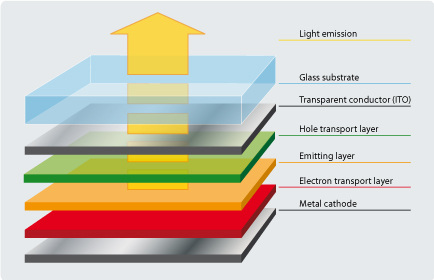So what exactly is an OLED? These diodes glow when an electrical current is applied to them[1], and are made primarily for TV and mobile devices. It is a next generation technology which will soon take over the current LED market. Due to this upcoming prominence, publishing companies are starting to look more closely at this technology and are beginning to apply it to their future models.
Samsung in particular, with their sub-company Samsung Publishing Ltd, who own the majority of the market share when it comes to smartphones have been declared the leader in OLED display research and the clear leader in AMOLED (Active Matrix OLED) production, holding a 98% share of this market[2]. Their displays are thinner and of better quality than that of LCD or plasma screens. Samsung distribute OLED screens to most mobile phone companies, and produce 40% of OLED displays.
First observations of this organic technology were actually made way back in the 1950s, and it has progressed from there.
OLEDs operate by using a variety of layers, outlined in the image below.
OLED displays allow the possibility to be fabricated on flexible plastic substrates, allowing for amazing new concepts such as roll up displays, displays which can bend and be manipulated without damage. Displays can also be embedded into clothing and fabrics for example. These are just a few of the reasons why publishing companies are taking a keen interest in OLED technology, as it opens a lot of doors for the future.
There is a flipside to the coin however. The steps needed to produce OLED displays are extremely expensive currently. The processes involved are time consuming compared to (for example) LCD alternatives.
Because of its organic nature, the lifespan of one of these displays is lower than current technologies. There are other disadvantages regarding things such as possible water damage etc, however truthfully publishers need not concern themselves with these, since it is more the responsibility of other aspects of the company.
One major thing that publishing companies should concern themselves with however is the fact that whilst OLED displays generally consume less power than traditional LCDs, when it comes to displaying white, for example a word document, the efficiency is blown out of proportion as OLEDs consume up to three times as much power. This is particularly a problem since the ebook market is so huge at this time, and word documents and books are very much prevalent in this industry.
In conclusion then, OLEDs are definitely the next big thing, particularly when it comes to smartphone technology, and we can certainly expect to see it become standardized in the near future.
Word count: 574
[1] What Are OLEDs? (No author) - http://dkc1.digikey.com/us/en/tod/Newhaven/OLED-Displays/OLED-Displays.html - Accessed 07/10/2013
[2] Samsung Market Share (No author) - http://www.oled-info.com/samsung-oled - Accessed 07/10/2013
OLED image: http://www.novaled.com/uploads/pics/g_Novaled_OLED_Structure.jpg - Accessed 07/10/2013
[3] Craig Freudenrich - http://electronics.howstuffworks.com/oled5.htm - Accessed 07/10/2013


 RSS Feed
RSS Feed